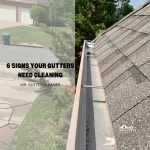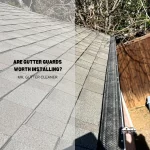Gutter guards, essential for home maintenance, often face problems like clogging with debris. Leaves, twigs, and other materials can block these guards, disrupting water flow and necessitating regular cleaning.
Incorrect installation is another common issue, where improper fitting leads to gaps or misalignments, reducing effectiveness.
Water overflow is a significant problem during heavy rains, as some gutter guard designs can impede water flow, risking foundation and landscaping damage.
These guards can also attract pests such as rodents and insects, especially if debris accumulates.
Durability is a concern, as certain materials may not withstand extreme weather, leading to cracks or warping.
In colder climates, gutter guards can contribute to ice dam formation, potentially damaging both the gutter system and the roof.
Lastly, gutter guards pose maintenance challenges, they often require removal for cleaning, which is more labor-intensive than maintaining gutters without guards.
Understanding Gutter Guard Functionality
Gutter guards are essential components in home maintenance, designed to protect gutters from debris while ensuring proper water flow. Their functionality revolves around filtering out leaves, twigs, and other materials that could cause blockages. This section delves into the operational basics of gutter guards and their importance in maintaining a home.
Basics of Gutter Guard Operation
Gutter guards operate by covering gutters to prevent debris accumulation while allowing water to pass through. Available in various types, such as mesh screens, foam inserts, and surface-tension systems, they are designed to attach to both the gutter and, in some cases, the roof. The primary function of these guards is to minimize the need for frequent gutter cleanings and to extend the life of the gutter system.
Table of Contents:
- Understanding Gutter Guard Functionality
- Problem 1: Clogging with Debris
- Problem 2: Incorrect Installation
- Problem 3: Water Overflow Issues
- Problem 4: Attraction of Pests
- Problem 5: Durability and Material Concerns
- Problem 6: Contribution to Ice Dams
- Problem 7: Maintenance Challenges
- Making an Informed Decision on Gutter Guards
Importance in Home Maintenance
In the realm of home maintenance, gutter guards serve a crucial role. They help prevent blockages in the gutter system, which can lead to water overflow and potential damage to a home’s foundation and exterior. By ensuring that water can flow freely through gutters and downspouts, gutter guards contribute significantly to the preservation of a home’s structural integrity and curb appeal.
Problem 1: Clogging with Debris
Clogging with debris is a primary concern for gutter guard systems, as it can significantly impede their effectiveness in protecting gutter functionality.
Causes of Clogging
Clogging in gutter guards primarily occurs due to the accumulation of leaves, twigs, and other debris. The extent of clogging often depends on factors such as the type of foliage around the property, weather conditions, and the specific design of the gutter guard.
Preventive Measures
To mitigate clogging, it’s advisable for homeowners to conduct regular inspections and cleaning of their gutter guards. Additionally, choosing a gutter guard design that suits the home’s specific environmental conditions and considering the trimming of nearby trees can significantly reduce the likelihood of clogging.
Problem 2: Incorrect Installation
Incorrect installation of gutter guards is a prevalent issue that can lead to various problems. This section focuses on the common mistakes made during installation and compares professional versus do-it-yourself (DIY) approaches.
Common Installation Mistakes
Mistakes in gutter guard installation can significantly compromise their effectiveness. Common errors include improper sizing and fitting, not securing guards firmly, overlooking the angle of installation relative to the roofline, and failing to consider the specific type of gutter and roof material. These mistakes can lead to gaps, sagging, or detachment of the guards, rendering them ineffective in protecting the gutter system.
Professional vs. DIY Installation
Deciding between professional and DIY installation of gutter guards depends on several factors, including the complexity of the gutter system, the homeowner’s skill level, and the type of gutter guards being installed. Professional installation ensures proper fitting and functionality, as experts are equipped with the right tools and knowledge. On the other hand, DIY installation can be more cost-effective for those with adequate skills and a simpler gutter system. However, it carries the risk of installation errors and potential long-term costs due to inefficiencies or damage.
Problem 3: Water Overflow Issues
Water overflow is a significant concern with gutter guards, often resulting from specific design flaws or installation errors. This problem can lead to water damage and other issues around the home.
Risks of Water Damage
Water overflow from gutter guards can lead to serious consequences, including damage to the home’s foundation, basement flooding, and deterioration of exterior walls and landscaping. Consistent water overflow can also promote mold and mildew growth, posing health risks and further damage. Additionally, persistent water buildup can attract pests and cause significant structural problems over time.
Design Flaws Leading to Overflow
Certain design flaws in gutter guards can contribute to water overflow. These include guards that are not appropriately matched to the amount of rainfall a region receives, poorly designed guards that impede water flow, and guards that don’t fit well with the existing gutter system. Choosing the right gutter guard design and ensuring proper installation are critical in preventing water overflow issues.
Problem 4: Attraction of Pests
The design and maintenance of gutter guards can inadvertently attract various pests, posing a challenge for homeowners.
Types of Pests Attracted
Gutter guards can become a haven for pests like rodents, insects, and birds, especially if debris accumulates on them. Rodents may use the space under poorly maintained gutter guards as a nesting area, while stagnant water can attract mosquitoes and other insects. Birds might also find gutter guards a convenient spot for nesting.
Solutions to Pest Problems
To mitigate pest issues, regular cleaning and maintenance of gutter guards are essential. Choosing gutter guard designs that minimize gaps and spaces where pests can enter is also crucial. In cases of severe infestation, consulting pest control professionals and considering a redesign or replacement of gutter guards may be necessary.
Problem 5: Durability and Material Concerns
The durability of gutter guards is a significant factor influencing their effectiveness and long-term performance.
Identifying Quality Materials
The choice of material greatly impacts the durability of gutter guards. Materials like aluminum and stainless steel are known for their longevity and resistance to weather elements. Plastic or vinyl guards, while initially less expensive, may degrade faster under harsh weather conditions. Evaluating the environmental factors and choosing materials accordingly is critical for durability.
Longevity of Different Gutter Guards
Different types of gutter guards offer varying levels of longevity. Mesh and micro-mesh guards typically offer longer life spans due to their resistance to rust and corrosion. Foam and brush-type guards might require more frequent replacement but provide ease of maintenance. The local climate, tree coverage, and frequency of rainfall are factors to consider when assessing the longevity of gutter guards. Regular inspection and timely maintenance can extend the life of any gutter guard system.
Problem 6: Contribution to Ice Dams
The presence of gutter guards can sometimes exacerbate the formation of ice dams on roofs, a significant issue in colder climates.
Understanding Ice Dam Formation
Ice dams occur when snow melts on a warm roof and refreezes at the colder eaves, creating a dam that prevents proper drainage through the gutters. Gutter guards can trap snow and ice, contributing to this problem. The ice dam formation can lead to water seeping under roof shingles, causing damage to the roof, attic, and interior walls.
Preventative Strategies for Ice Dams
To prevent ice dams, it’s crucial to maintain an even roof temperature. This can be achieved through proper attic insulation and ventilation, preventing heat from escaping through the roof. Regularly removing snow from the roof can also help, as can installing heated cables in gutters and downspouts to promote melting. Choosing gutter guards designed for cold climates can also minimize the risk of ice dam formation.
Problem 7: Maintenance Challenges
Effective maintenance of gutter guards is vital to ensure their long-term performance and protect your home from water-related damages.
Effective Cleaning Techniques
Even with gutter guards, periodic cleaning is necessary to ensure optimal functionality. Techniques include using a garden hose to flush out debris, employing specialized gutter cleaning tools, or, for more accessible gutter guard designs, manually removing and cleaning the guards. Regular inspections, especially after storms or heavy winds, can help identify and address any blockages or damage promptly.
Balancing Maintenance and Effectiveness
Striking a balance between maintenance and effectiveness involves choosing the right type of gutter guard for the specific environment and ensuring regular upkeep. While some guards may require less frequent cleaning, they might not be as effective in certain conditions and vice versa. Homeowners should consider their ability to maintain the guards against their need for effectiveness in blocking debris.
Making an Informed Decision on Gutter Guards
Selecting the appropriate gutter guard system is key for ensuring long-term effectiveness and safeguarding your home against water-related issues.
Assessing Your Home’s Needs
Assessing a home’s needs involves considering factors like the type and amount of foliage around the house, the average rainfall and snowfall, roof type, and gutter size. Homeowners should also evaluate their willingness and ability to perform regular maintenance.
Choosing the Right Gutter Guard System
Choosing the right gutter guard system requires balancing factors such as cost, effectiveness, durability, and maintenance requirements. It’s advisable to research different types of gutter guards, consult with professionals, and read reviews from other homeowners. A well-informed decision will lead to a gutter guard system that meets the specific needs of the home while providing long-term, hassle-free protection.


